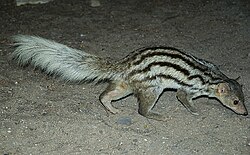| Galidictis | |
|---|---|
 | |
| Grandidier's mongoose (Galidictis grandidieri) | |
| Scientific classification | |
| Domain: | Eukaryota |
| Kingdom: | Animalia |
| Phylum: | Chordata |
| Class: | Mammalia |
| Order: | Carnivora |
| Suborder: | Feliformia |
| Family: | Eupleridae |
| Subfamily: | Galidiinae |
| Genus: | Galidictis I. Geoffroy Saint-Hilaire, 1839 |
| Type species | |
| Mustela striata I. Geoffroy Saint-Hilaire, 1837 | |
| Species | |
 | |
| Galidictis ranges | |
Galidictis is a genus in the subfamily Galidiinae of the family Eupleridae: a group of carnivorans that are endemic to Madagascar. [1]
The name is from two ancient Greek words that both approximately mean ‘weasel’: galid- (see Galidia ) and iktis . [2] Compare the word Galictis (grison, a closer relative of the weasel).
It contains the following two species and two subspecies: [1]
| Image | Scientific name | Subspecies | Common name | Distribution |
|---|---|---|---|---|
| Galidictis fasciata |
| Broad-striped Malagasy mongoose | Madagascar | |
 | Galidictis grandidieri | Grandidier's mongoose | Madagascar | |